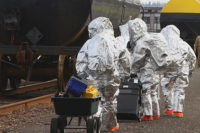Is industrial hygiene as you know it disappearing?
Consider some recent evidence:
- Within a three-month period last year, six industrial hygienists lost their jobs with Philadelphia-area healthcare, manufacturing, and service companies, according to Chris Schneider, an IH consultant. "They lost their jobs because they weren't able to communicate the benefits of what they were doing," he says. Four are still looking for work. One found a lower-paying job in health and safety. Another is giving consulting a shot, on his own.
- According to surveys conducted by the American Industrial Hygiene Association, members spend slightly more than half their time these days (50-55 percent) on so-called traditional industrial hygiene--monitoring toxic exposures and interpreting regulatory standards. Almost an equal amount of time is taken up with safety, environmental, and other issues. More than 40 percent say they will probably reposition themselves in environmental management in the future.
These findings reflect the "beginning of the end of industrial hygiene as we know it," according to one association report.
- By December, 1998, new letterhead might be in order for the American Industrial Hygiene Association. The group is in the process of considering a name change.
"'Hygiene' is an archaic term," says 39-year-old Jack Hawkins, a certified industrial hygienist in Indiana. "ŒIndustrial' should also be taken out and replaced with 'occupational'," he says confidently. Hawkins may soon get his wish.
With the duties of IHs broadening, a name reflecting new environmental and safety responsibilities would clarify the profession to outsiders, say many IHs. AIHA formed a task force to take up the name-change issue after research completed with the three major IH organizations revealed a desire to modernize the profession's identity. AIHA has been conducting focus groups on new names, and officials hope to narrow the options and have members vote by year's end on a name to replace the one used throughout the organization's 59-year history.
Sources say the "Society for Occupational and Environmental Health Sciences" is a leading contender at this point.
Aside from a new association name, a number of IHs interviewed for this article expect the term "industrial hygienist" to disappear over the next 10-15 years as a job description. Usha Wright, an AIHA board member, says "environment, safety and health officer" best describes the work she does. AIHA President Jeff Burton says he came into the field as an industrial hygiene engineer, but now the title ¿occupational health scientist" rings truer.
The need remains
Do these developments mean you're not going to be able to find anyone to perform the basics of industrial hygiene: anticipating, detecting, evaluating, and controlling dangerous exposures on the job? Not at all, according to more than a dozen IH experts interviewed for this article. Most of those interviewed still do traditional hands-on work to some extent. In fact, some would have it no other way.Lee Davis, chief executive officer for Galson Company, employer of Chris Schneider, recalls a consultant leaving Galson's Syracuse office to strike out on his own because he wanted to focus on the technical side exclusively.
Names, titles, and job definitions will change, but the experts doing IH work won't vanish, say a broad cross-section of young and old professionals. The health of employees will always need to be protected.
What's up for debate are these questions:
- Who will do traditional IH work?
- How many people will be needed to do that work?
- How will the industrial hygiene profession be different in the 21st century?
Who does the work?
"Frankly, many of the things we do could be done by employees," says one industrial hygienist who requested anonymity, in part to protect his job.There was a fairly even split among IHs interviewed for this story as to whether technicians will take over for more highly educated--and expensive--professionals. A technician take-over has been predicted for years, but it hasn't happened yet, says an AIHA board member. Professionals will always be needed to analyze results and plot ways to control hazards, says another IH.
Most IHs interviewed agree that professional certification is not essential to doing good work. Competence can be measured by on-the-job results: audit reports and exposure records. Still, certification is increasingly popular. Most people interviewed for this story are certified industrial hygienists. Eighty-eight percent of AIHA members surveyed plan to be certified in the next five years. The reasons often relate to career marketability: to get teaching jobs or move into management.
How many IHs are needed?
There's a feeling among some industrial hygienists that their field is saturated after experiencing booming growth in the 1980s, thanks to OSHA regulations and the asbestos scare. Now OSHA isn't issuing many new standards. Advances in direct-reading portable monitors and closed-system, real-time computerized monitoring allow technicians to do more of the grunt work. Plus, many gross chemical exposure problems have been eliminated after decades of hard work by IHs, and also due to manufacturing processes becoming more automated, or moving overseas.Modern science is allowing fewer industrial hygienists to be far more effective, says Darrell Mattheis, who tracks IH issues for Organization Resources Counselors.
AIHA President Jeff Burton says the group's growth rate seems to have plateaued, with membership at around 13,000, but it's not shrinking. In recent years, more members have gone into consulting, representing upwards of one-quarter of the membership and reflecting the trend in industry to outsource traditional exposure monitoring work.
There doesn't seem to be any slackening of demand for IH services. For example, a Galson branch office in Plymouth Meeting, Pa., was as quiet as an arcade on a school day when visited for this article. A white, dry-erase board with each employee's name printed on it sported a black dot in either the "in" or "out" column depending on the whereabouts of each of the 16 employees. A third column listed their location. Only four black dots spanned the "in" column: Three consultants were combating a mold problem in the Nazareth School District two hours to the north, and eight others were out tending to various clients on a brisk but sunny winter day.
According to Schneider, Galson's business increased 28 percent in all market areas in fiscal year 1996, and 42 percent in fiscal '97.
Galson's growth could reflect shifts in who demands IH services. Many large corporations now have exposures under control, but smaller, less sophisticated businesses need experts to help solve problems in operations such as metalworking. Schools, hospitals, and construction sites wrestle with lead, asbestos, and chemical exposure hazards.
New roles
Faced with shifting markets for services, a decline in regulations that have boosted careers for a generation, and increasing use of employees and contractors to handle technical work, the industrial hygiene profession is in the midst of some soul-searching. Early in 1997, an AIHA task force on redefining the profession asked members how their jobs should be defined using today's terminology.The survey revealed--and interviews for this article confirm--that most IHs are branching out, taking on safety and environmental work to stay competitive in the job market. Most of those interviewed have environmental or safety degrees--some have both. About one-third of AIHA members surveyed are certified safety professionals.
Some IHs have been moving in this direction for years. Ten years ago, a CIH in North Carolina was assigned to fill an environmental engineering position in his company. Already working with environmental regs as an IH, he decided to take the job himself so he could beef up even more on EPA compliance to improve his marketability. To fill his own spot, he hired another CIH, who was also able to add environmental training to his resume.
Industrial Safety & Hygiene News' White Paper findings in recent years have documented this crossover trend. In 1995, for example, 78 percent of IHs surveyed expected to expand their job duties to include environmental and safety. AIHA's most recent survey reveals 62 percent of IHs expect to follow the same career path in the next five years.
"You can hit a saturation point technically," says Schneider. "I would not have a job now if I had not shifted my focus."
Schneider taught himself marketing basics to better pitch recommendations to clients. He says marketing skills are a priority for IHs now. "If you can't sell or manage, and can only offer technical knowledge, how can you justify your existence?" he asks.
Many IHs see the need to be able to talk finances. More than one-third of the IHs responding to ISHN's White Paper survey last year said measuring the cost-benefit, value-added contribution of environmental health and safety work is "very important" to their careers.
More and more, OSHA requirements are only one factor in a cost-effective EHS business plan that must be sold to managers. Don't rely on regulations to sell EHS anymore, say many IHs. In many cases, OSHA fines have lost their punch, especially as more employers realize fines can be negotiated down. Today, employers are interested in risk reduction, says Schneider. What hazards can lead to lawsuits? How can bottom-line losses relating to EHS be prevented?
Future drivers
OSHA isn't the force it once was, but IHs see other issues and trends driving the need for the expanded array of EHS services they can deliver. For example:
- Thirty-seven percent of IHs surveyed for last year's White Paper believe total quality management programs will push the growth of the profession in the next five to ten years. Steven Levine, professor of industrial health for the University of Michigan and director of the World Health Organization Collaborating Center for Occupational Health, explains that the increasingly global nature of business will encourage professionals to marry IH work with ISO standards in order to compete for contracts.
- International growth will drive the future of IH, says AIHA board member Gayla McCluskey. Forty percent of IHs surveyed for last year's White Paper concur, predicting that international EHS standards will shape the profession in the next five to ten years.
Jeff Burton, the group's president, says he sees more EHS managers working internationally now than ever before. "We'll send a team of one IH and two technicians overseas for some jobs," says Galson's Davis. They stay for weeks at a time. Projects like this are becoming more commonplace, say others.
- The environmental field entices many IHs because EPA is the "most politically powerful agency in Washington," according to one source. Its stature dwarfs OSHA's, with an annual budget more than 20 times the size of the safety and health agency's, and with its boss on the cover of national magazines such as Forbes.
EPA has clout that OSHA can only dream of. Its multi-million-dollar fines make headlines, and its skilled political leaders always seem to put the agency in the middle of the latest health scare. Plus, they're able to rally support for tough regulations by leveraging EPA's role in protecting children, parks, drinking water, the air everyone breathes, and neighborhood backyards.
IHs interviewed for this article are becoming adept at recognizing and adapting to the forces shaping their careers, and their profession. So are their organizations, such as AIHA. That's why you may see names and titles change. But the work goes on, for reasons that increasingly go beyond OSHA regs. That work will be done by a growing mix of consultants, in-house personnel, and employee technicians; in a range of large and small worksites; and in an expanding number of countries around the world. Industrial hygiene is diversifying, but it's not disappearing, say those closest to the field.



